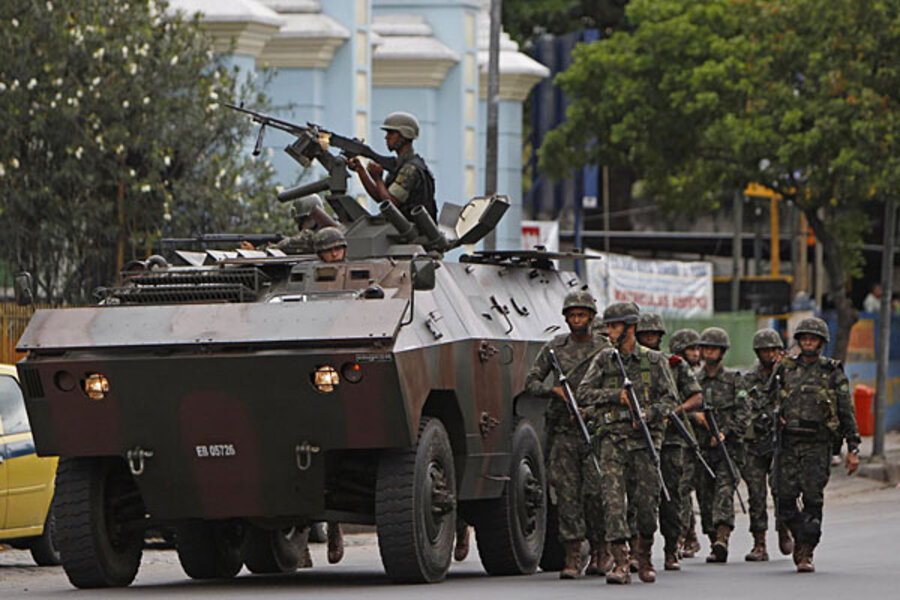Amid violent flareup in Rio, Brazil defends its security strategy
Loading...
| Rio de Janeiro, Brazil
With more than two dozen killed in a week across Rio de Janeiro in gang-related violence, reporters pressed the visibly weary Rio State Security Secretary José Mariano Beltrame on the efficacy of an aggressive two-year-old security program: Are criminals being effectively vanquished or just changing their addresses?
“We came here with about 500 homicides [per month, 15 months ago]. We are today with about 350,” Mr. Beltrame answered pragmatically at a press conference last night. He added that those numbers were still “horrible.”
It is the same question increasingly being asked since Sunday, as dozens of cars, buses, and vans have been set ablaze in an apparently coordinated assault from the city’s entrenched organized crime members. (One newspaper has totaled the number of burnings to 98 in six days, following an afternoon bus arson today.) Authorities have said criminals are sending a message of opposition to the police crackdown on their strongholds, mostly in favelas throughout the city, which is the second-largest in Brazil.
Some 196 people have been arrested and 32 killed in this episode, the military police said today. In many cases, armed bandits have forced motorists from their vehicles to rob them and set the cars on fire, usually not incurring deaths, though a young girl was reportedly killed in crossfire while she was on the computer at home, and one father shot to death when he didn’t obey orders to stop while driving with his kids. Rio Mayor Eduardo Paes has called the attacks “terrorism.”
The Rio government maintains that the swell of violence is a sign that criminals are on the defensive and that the policing model is working. That model involves invading, occupying, and setting up permanent policing units in Rio’s shantytowns, or favelas, which have long served as a base for organized crime. But because of a lack of manpower and the magnitude of the violence problem in Rio, some say the program has not been as effective as it could be – and that it focuses on hotspots near tourist areas, simply pushing criminals to the margins of the city. This latest violence could be signaling its weaknesses.
Favela residents largely welcome effective, respectful policing, but the placement of Units of Police Pacification (UPPs) has been skewed, says Tião Santos, a member of the National Council on Public Security. “The security policy in Rio are concentrated in the areas of the South Zone [which includes popular tourist neighborhoods Copacabana and Ipanema], or where big sporting events occur,” he says. He adds that the UPPs are notably effective, but that there are few of them, given that Rio has more than 1,000 favelas. A few dozen favelas are now covered by UPPs, which the state public security ministry says benefits about 200,000 people.
“Rio [for decades] had a policy of nonintervention in the hills,” says Leandro Piquet Carneiro, a professor at the University of São Paulo who helped devise the UPP strategy. Many of the favelas hang precariously on the city's steep hills. “Organized crime [networks] became tyrannical republics.”
By 2014, when Brazil hosts the World Cup, the government hopes to have 40 UPPs in 165 communities, with 10,000 police. Rio hosts the summer Olympics in 2016.
But Rio security authorities say they do not have the policing manpower to cover all the favelas. As state secretary Beltrame told reporters last night, it’s a balance. “This is a calculation,” he said, “the preservation of human lives.”
In the meantime, the violence continues. Today, Army reinforcements circled the Complexo do Alemão, a large slum in the north of the city. Rio authorities have long recognized that the slum has become a haven for organized crime members who have fled security operations further south. As about 500 military and civil police overtook a neighboring favela Vila Cruziero last night, using armored vehicles on loan from the Brazilian Navy, news helicopter footage caught a mass exodus of armed men toward the Complexo.





